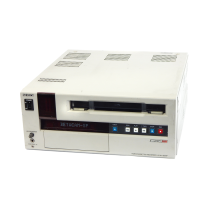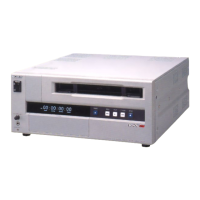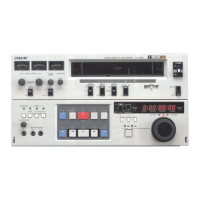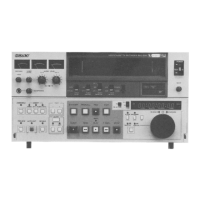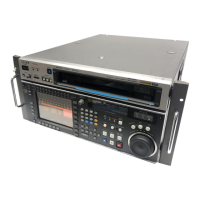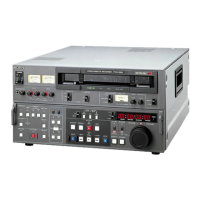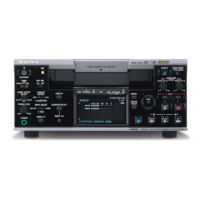Do you have a question about the Sony UVW-1800P and is the answer not in the manual?
Details the capabilities and characteristics of the UVW-1800/1800P Betacam SP videocassette recorder.
Details the layout and functions of buttons, indicators, and connections on the front panel of the unit.
Identifies and explains the video, audio, power, time code, and control signal connectors located on the rear panel.
Provides essential safety guidelines and notes for operating and storing the videocassette recorder.
Explains how to insert, eject, and manage Betacam SP cassettes.
Details how to protect recorded material by using the cassette's record-inhibit plug.
Describes the importance and connection of reference video signals for stable operation and TBC functionality.
Details the necessary connections, switch settings, and procedures for playing back video and audio signals.
Explains connections, switch settings, and procedures for recording video and audio signals, including component signals.
Covers how to display time data and operating status as superimposed text on the monitor output.
Describes system configuration and connections for performing cut editing with the UVW-1800/1800P as a recorder.
Illustrates the system configuration and switch settings for A/B roll editing using multiple units.
Explains how to use a Vectorscope to adjust sync and subcarrier phase for stable editing.
Describes how to display CTL signal count values, longitudinal time codes (LTC), and user bit data.
Details the procedure for presetting longitudinal time code (LTC) and user bit data for recording.
Explains the running modes of the internal time code generator and how to set time data to reflect real time.
Explains the menu structure, hierarchical organization, and how menu screens are displayed.
Covers the operation sequence for navigating menus, changing settings, and saving configurations.
Describes self-diagnosis features and actions to take in case of condensation detected on the head drum.
Explains how to view and reset the cumulative operating time data displayed by the digital hours meter.
Details the procedure for cleaning the video and audio heads using a special cleaning cassette.
Lists alarm messages displayed on the monitor and time counter, including their causes and recommended actions.
Provides solutions for common operational problems, focusing on monitor display and signal issues.
Details the technical specifications of the unit, including audio system, processor adjustment range, and input connectors.
Provides definitions for technical terms and concepts used throughout the manual, such as TBC, SMPTE, and Time Code.
Details the capabilities and characteristics of the UVW-1800/1800P Betacam SP videocassette recorder.
Details the layout and functions of buttons, indicators, and connections on the front panel of the unit.
Identifies and explains the video, audio, power, time code, and control signal connectors located on the rear panel.
Provides essential safety guidelines and notes for operating and storing the videocassette recorder.
Explains how to insert, eject, and manage Betacam SP cassettes.
Details how to protect recorded material by using the cassette's record-inhibit plug.
Describes the importance and connection of reference video signals for stable operation and TBC functionality.
Details the necessary connections, switch settings, and procedures for playing back video and audio signals.
Explains connections, switch settings, and procedures for recording video and audio signals, including component signals.
Covers how to display time data and operating status as superimposed text on the monitor output.
Describes system configuration and connections for performing cut editing with the UVW-1800/1800P as a recorder.
Illustrates the system configuration and switch settings for A/B roll editing using multiple units.
Explains how to use a Vectorscope to adjust sync and subcarrier phase for stable editing.
Describes how to display CTL signal count values, longitudinal time codes (LTC), and user bit data.
Details the procedure for presetting longitudinal time code (LTC) and user bit data for recording.
Explains the running modes of the internal time code generator and how to set time data to reflect real time.
Explains the menu structure, hierarchical organization, and how menu screens are displayed.
Covers the operation sequence for navigating menus, changing settings, and saving configurations.
Describes self-diagnosis features and actions to take in case of condensation detected on the head drum.
Explains how to view and reset the cumulative operating time data displayed by the digital hours meter.
Details the procedure for cleaning the video and audio heads using a special cleaning cassette.
Lists alarm messages displayed on the monitor and time counter, including their causes and recommended actions.
Provides solutions for common operational problems, focusing on monitor display and signal issues.
Details the technical specifications of the unit, including audio system, processor adjustment range, and input connectors.
Provides definitions for technical terms and concepts used throughout the manual, such as TBC, SMPTE, and Time Code.
| Type | Professional VCR |
|---|---|
| Format | Betacam SP |
| Power Requirements | AC 100-240V, 50/60Hz |
| Audio Tracks | 2 tracks |
| Video Heads | 4 |
| Frequency Response | 20 Hz to 20 kHz |
| Signal-to-Noise Ratio | 48 dB |
| Video System | NTSC/PAL |
